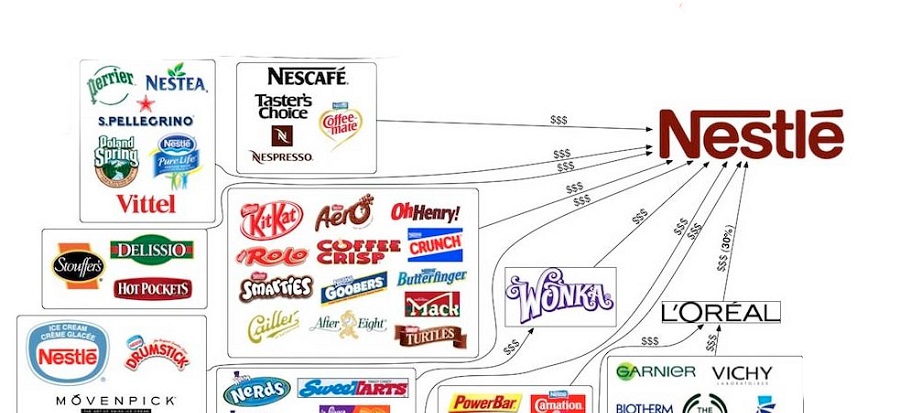Nestle is a Swiss multinational food and drink processing conglomerate. They have a wide range of products, including candy. Some examples of Nestle candy brands include Butterfinger, Crunch, Baby Ruth, and 100 Grand. Nestle also owns other candy brands like Wonka and Nerds. Nestle's candy is widely available in many countries around the world and is known for its taste and quality.
What types of candy does Nestle produce?
Nestle produces a variety of different types of candy, including chocolate bars, pieces of chocolate, chewy cand and gummies, hard cand, and chocolate-covered treats. Some popular Nestle candy brands include Butterfinger, Crunch, Baby Ruth, 100 Grand, Wonka, and Nerds. Each of these brands offers a variety of different types of candy, such as chocolate bars, bite-size cand, and candy-coated chocolate pieces. Nestle also produces seasonal and limited edition cand. They are also known for the production of chocolate bars in different sizes and varieties such as dark chocolate, milk chocolate, white chocolate etc.
How long has Nestle been in the candy industry?
Nestle has a long history in the food and beverage industry, dating back to 1866 when it was founded by Henri Nestle in Switzerland. The company has been involved in the candy industry for many decades. Nestle acquired some of its most well-known candy brands, such as Butterfinger and Crunch, in the 1980s and 1990s. The company has been expanding its candy portfolio through acquisitions and partnerships over the years, making it one of the leading players in the global candy market. While the exact date of when Nestle start producing candy is not clear, it is safe to say that Nestle has been in the candy industry for more than 100 years.
What is the history of Nestle's candy brand?
Nestle's candy brand has a long and rich history, dating back to the late 19th century when Henri Nestle, a Swiss pharmacist, created a life-saving infant food. The company then diversified into different food products, including candy. Over the years, Nestle has acquired many well-known candy brands, such as Butterfinger and Crunch, which were both developed in the 1920s and 1930s respectively.
In the 1980s and 1990s, Nestle acquired a number of American candy brands, including Baby Ruth, 100 Grand and Wonka, which helped to establish the company as a major player in the U.S. candy market.
In recent years, Nestle has continued to expand its candy portfolio through acquisitions and partnerships, such as the acquisition of Rowntree's and the creation of a joint venture with Ritter Sport, a German chocolate maker. Today, Nestle's candy brand is known for its wide range of products, including chocolate bars, pieces of chocolate, chewy cand and gummies, hard cand, and chocolate-covered treats, which are enjoyed by people all over the world.
What are some of Nestle's most popular candy products?
Some of Nestle's most popular candy products include:
-
Butterfinger: A chocolate-covered peanut butter crisp bar first introduced in 1923.
-
Crunch: A chocolate bar with a crisped rice center, first introduced in 1938.
-
Baby Ruth: A chocolate-covered candy bar with peanuts and caramel, first introduced in 1921.
-
100 Grand: A chocolate bar with a chewy caramel center, first introduced in 1966.
-
Wonka: A brand of cand that includes a variety of chocolate bars, gummies and chews, as well as other confections, such as Nerds and Runts.
-
Nestle chocolate bars: Nestle produces a wide range of chocolate bars, including Milk Chocolate, Dark Chocolate, and White Chocolate that are popular globally.
-
Smarties: A brand of tablet cand that comes in a variety of colors and flavors, first introduced in 1949.
These cand are well known and popular in many countries, they could be found in most of the supermarkets and convenient stores.
How does Nestle source the ingredients for its candy?
Nestle, like most large food companies, sources ingredients for its candy products from a variety of suppliers. The company has a robust sourcing program in place to ensure that the ingredients used in its products meet its high quality standards, and that the sourcing is done in an ethical and sustainable way.
The cocoa used to make Nestle's chocolate cand is sourced through a variety of channels, including direct sourcing from farmers and co-operatives, and sourcing through partnerships with organizations that promote sustainable cocoa farming. Nestle also sources ingredients such as sugar, milk, and nuts from suppliers that meet the company's sustainability standards.
Nestle also engages in responsible sourcing of ingredients, this includes sourcing of ingredients in a way that respects human rights, labor rights and the environment. Nestle's responsible sourcing program also includes monitoring and auditing suppliers to ensure they meet the company's standards.
The company has also committed to using 100% sustainable cocoa by 2025, this means that all the cocoa used in Nestle's chocolate products will be sourced from farms that meet the company's sustainability standards.
What steps does Nestle take to ensure the quality of its candy?
Nestle takes a number of steps to ensure the quality of its candy products, including:
-
Ingredient sourcing: As mentioned before, Nestle has a robust sourcing program in place to ensure that the ingredients used in its products meet its high quality standards, and that the sourcing is done in an ethical and sustainable way.
-
Quality control: Nestle has a strict quality control process in place to ensure that its products meet its high standards. The company has a dedicated quality control team that monitors and tests products at various stages of production, from raw materials to finished products, to ensure that they meet the company's specifications.
-
Food Safety: Nestle has in place strict food safety standards and guidelines to ensure that the cand it produces is safe for consumption. This includes following the regulations and guidelines of each country it operates in, as well as implementing its own internal food safety standards.
-
Traceability: Nestle has implemented a traceability system that allows them to trace their products back to the source of the ingredients. This allows the company to quickly identify and address any issues that may arise with a specific batch of products.
-
Continuous improvement: Nestle is committed to continuous improvement in all aspects of its business, including quality control. The company regularly reviews and updates its quality control processes to ensure that they are in line with the latest industry standards and regulations.
These steps are taken to ensure that Nestle's candy products are of the highest quality, safe to consume and meet the customers' expectations.
What is Nestle's approach to sustainability in its candy production?
Nestle has a strong commitment to sustainability in its candy production. The company's approach to sustainability includes a focus on:
-
Responsible sourcing: Nestle engages in responsible sourcing of ingredients for its candy products, this includes sourcing of ingredients in a way that respects human rights, labor rights and the environment. Nestle's responsible sourcing program also includes monitoring and auditing suppliers to ensure they meet the company's standards.
-
Sustainable cocoa: Nestle is committed to using 100% sustainable cocoa by 2025, this means that all the cocoa used in Nestle's chocolate products will be sourced from farms that meet the company's sustainability standards. The company has also committed to support farmers to improve the quality and productivity of their cocoa and to develop their livelihoods.
-
Water stewardship: Nestle is committed to responsible water use and management. The company aims to reduce its water use in its operations and support communities to manage water resources sustainably.
-
Climate change: Nestle is committed to reducing greenhouse gas emissions and to support communities to adapt to climate change.
-
Packaging: Nestle is committed to designing and producing packaging that is environmentally friendly and easy to recycle. The company has made a commitment to make 100% of its packaging recyclable or reusable by 2025.
These commitments and actions demonstrate Nestle's commitment to sustainability in its candy production, and its efforts to minimize the environmental impact of its operations while promoting sustainable development of its suppliers and communities.
How does Nestle's candy portfolio compare to its competitors in the industry?
Nestle is one of the largest food and beverage companies in the world, and its candy portfolio is extensive and diverse. The company has a wide range of candy products, including chocolate bars, pieces of chocolate, chewy cand and gummies, hard cand, and chocolate-covered treats, under various brands such as Butterfinger, Crunch, Baby Ruth, 100 Grand, Wonka and Nerds. This diverse portfolio allows Nestle to appeal to a wide range of consumers and to be present in various segments of the candy market.
In terms of market share, Nestle is one of the leading players in the global candy market. According to recent data, Nestle is the largest confectionery company in the world, with a market share of around 8%. Nestle competes with other large global confectionery companies such as Mars, Hershey's, and Mondelez, which also have a significant market share.
In comparison to its competitors, Nestle has a strong and diverse portfolio of candy products and a long-standing reputation for quality and taste. It also has a strong focus on sustainability and responsible sourcing. Nestle has a large distribution network and its products are available in most countries around the world. However, the company faces competition from other big brands in the market, which also have a wide range of products and a strong reputation for quality.
How does Nestle market its candy products to consumers?
Nestle markets its candy products to consumers through a variety of channels, including:
-
Advertising: Nestle uses traditional and digital advertising to promote its candy products. This includes television and radio commercials, print ads in magazines and newspapers, and online ads on social media and other websites.
-
Promotion: Nestle runs promotions and discounts to encourage consumers to try its candy products. This includes in-store promotions, coupons, and limited-time offers.
-
Branding: Nestle uses strong branding and packaging to make its candy products stand out on store shelves. The company's products are easily recognizable by their packaging and branding, which helps to attract consumers and build brand loyalty.
-
Social Media: Nestle uses social media platforms to connect with consumers and promote its candy products. The company regularly posts on its social media accounts, highlighting new products, promoting special offers and running campaigns to increase brand awareness.
-
Public Relations: Nestle uses public relations to generate positive media coverage for its candy products, for example by participating in events and trade shows.
-
Influencer Marketing: Nestle partners with social media influencers and celebrities to promote its candy products. This can include product placement, sponsored posts and other forms of collaborations.
These marketing strategies are used to create awareness, generate interest and drive purchase of Nestle's candy products. The company also adapts its marketing strategies to the local market, taking into account cultural and consumer behavior differences.


